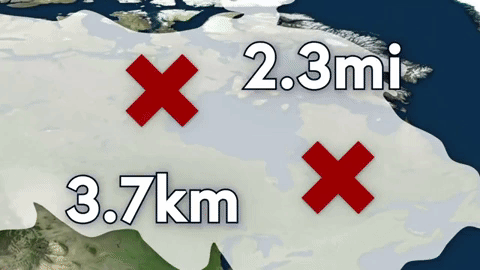The Hudson Bay region of Canada has less gravity than it’s supposed to. The reasons for the shortage have puzzled scientists for decades.
Gravity isn’t uniform all over the Earth’s surface. It’s a result of mass, which means the varying density of the Earth at different locations can affect how much you weigh there. Canadians aren’t all free-floating like Sandra Bullock, but the effect is definitely measurable. In the Hudson Bay region, the average resident weighs about a tenth of an ounce less than they would weigh elsewhere.
Researchers have puzzled for years over whether this was due to the crust there rebounding slowly after the end of the last ice age or a deeper issue involving convection in the Earth’s mantle or some combination of the two.
Now, ultra-precise measurements taken over four years by a pair of satellites known as GRACE (Gravity Recovery and Climate Experiment) reveal that each effect is equally responsible for Canada’s low gravity. The work could shed light on how continents form and evolve over time.
The two spacecraft fly 500 kilometres above the Earth, 220 kilometres apart. Using a microwave ranging system, the two spacecraft can measure distance differences between them as tiny as a micron. That allows them to measure tiny changes in the distribution of mass and hence gravity on the Earth. For example, if the leading spacecraft were to encounter an area with more gravity, it would be pulled ever-so-slightly closer to Earth than the trailing spacecraft, and that distance can be measured.
At first, researchers suspected it was due to an ice sheet called Laurentide that blanketed a sizeable chunk of North America during the last ice age. In places, the sheet was more than 3 kilometres thick, and it depressed the Earth’s crust beneath it.
When the ice age ended about 20,000 years ago, the ice rapidly melted. But the crust has been springing back much more slowly, and it is rebounding today by about 12 millimetres per year. But in the last decade or so, scientists have begun to suspect that convection in the Earth’s mantle, a layer of hot, flowing rock beneath the crust, also plays a role.
The sludge-like mantle rises and falls in plumes as it is heated from below and cooled from above. The mantle can drag the overlying tectonic plates with it as it moves. GRACE cannot directly detect that movement since it is so slow. But scientists inferred the gravitational contribution of convection by subtracting the post-glacier effect from the region’s overall gravity signal.
Even after the Earth’s crust rebounds completely from the glacier melting, there may still be a gravitational low over the area due to mantle convection. That would suggest that even parts of a continent away from the tectonic plate boundaries are affected by mantle convection.
In simple word during the last ice age, Canada was covered by a vast glacier called the Laurentide Ice Sheet. This sheet was two miles thick over northern Quebec and stretched as far south as modern-day New York and Chicago.
Ice is heavy, so five million square miles of it pushed down on the rock underneath, squishing it like a Nerf ball. When the ice began to melt, about 21,000 years ago, the Earth began to spring back, but, like a Nerf ball, it takes a while. To this day, the Earth in the Hudson Bay region is still deformed, with lots of rock-mass having been pushed outward by all the ice. Less mass means less gravity.
